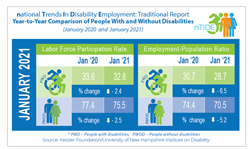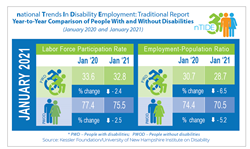
“We should see improvement in the employment-to-population ratio in coming months as the stimulus bills kick in and vaccines are more widely distributed,” said John O’Neill, PhD, director of the Center for Employment and Disability Research at Kessler Foundation.
EAST ANOVER, N.J. (PRWEB)
February 05, 2021
National Trends in Disability Employment (nTIDE) – issued semi-monthly by Kessler Foundation and the University of New Hampshire
As COVID-19 outbreaks continue to affect national and local economies, the job market struggled to maintain momentum, according to today’s National Trends in Disability Employment – Monthly Update (nTIDE), issued by Kessler Foundation and the University of New Hampshire’s Institute on Disability (UNH-IOD). In the coming months, prospects for recovery may improve as vaccine availability increases and the federal government implements new public health measures and considers additional economic relief.
nTIDE COVID Update (month-to-month comparison)
In the Bureau of Labor Statistics (BLS) Jobs Report released Friday, the employment-to-population ratio for working-age people with disabilities decreased from 29.4 percent in December 2020 to 28.7 percent in January 2021 (down 2.4 percent or 0.7 percentage points). For working-age people without disabilities, the employment-to-population ratio also decreased from 70.9 percent in December 2020 to 70.5 percent in January 2021 (down 0.6 percent or 0.4 percentage points). The employment-to-population ratio, a key indicator, reflects the percentage of people who are working relative to the total population (the number of people working divided by the number of people in the total population multiplied by 100).
“In January, we saw a decrease in the employment-to-population ratio as COVID-19 infections spiked across the nation following the Christmas and New Year holidays,” said John O’Neill, PhD, director of the Center for Employment and Disability Research at Kessler Foundation. “We should see improvement in the employment-to-population ratio in coming months as the stimulus bills kick in and vaccines are more widely distributed,” he added.
The labor force participation rate for working-age people with disabilities decreased from 33.2 percent in December 2020 to 32.8 percent in January 2021 (down 1.2 percent or 0.4 percentage points). For working-age people without disabilities, the labor force participation rate also decreased from 75.7 percent in December 2020 to 75.5 percent in January 2021 (down 0.3 percent or 0.2 percentage points). The labor force participation rate is the percentage of the population that is working, not working and on temporary layoff, or not working and actively looking for work.
“The labor force participation rate for people with disabilities also declined slightly in January,” noted economist Andrew Houtenville, PhD, research director of the University of New Hampshire’s Institute on Disability. “Over the course of the pandemic, we have seen people with disabilities staying engaged in the workforce by either working, actively looking for work, or still expecting to be recalled. The decline in January may reflect the reinstatement of restrictions to stop the increasing spread of COVID-19.”
Traditional nTIDE Numbers (comparison to the same time last year)
The employment-to-population ratio for working-age people with disabilities decreased from 30.7 percent in January 2020 to 28.7 percent in January 2021 (down 6.5 percent or 2 percentage points). For working-age people without disabilities, the employment-to-population ratio also decreased from 74.4 percent in January 2020 to 70.5 percent in January 2021 (down 5.2 percent or 3.9 percentage points).
The labor force participation rate for working-age people with disabilities decreased from 33.6 percent in January 2020 to 32.8 percent in January 2021 (down 2.4 percent or 0.8 percentage points). For working-age people without disabilities, the labor force participation rate also decreased from 77.4 percent in January 2020 to 75.5 percent in January 2021 (down 2.5 percent or 1.9 percentage points).
In January 2021, among workers ages 16-64, the 4,279,000 workers with disabilities represented 3.1 percent of the total 138,541,000 workers in the U.S.
nTIDE COVID Update – Friday, February 19 at 12:00 pm Eastern
Stay tuned for our mid-month update about the employment of people with disabilities as we follow the impact of COVID-19 and look at the numbers in more detail.
Ask Questions about Disability and Employment
Join our nTIDE Lunch & Learn series today, February 5, at 12:00 pm Eastern. This live broadcast, hosted via Zoom Webinar, offers attendees Q&A on the latest nTIDE findings, provides news and updates from the field, as well as invited panelists to discuss current disability-related findings and events. Today, Day Al-Mohamed, author, filmmaker, and disability policy executive, joins Dr. Houtenville, Dr. O’Neill from Kessler Foundation, and Denise Rozell, Policy Strategist at AUCD. Join live or watch the recordings at: ResearchonDisability.org/nTIDE.
NOTE: The statistics in the nTIDE are based on Bureau of Labor Statistics numbers but are not identical. They are customized by UNH to combine the statistics for men and women of working age (16 to 64). nTIDE is funded, in part, by grants from the National Institute on Disability, Independent Living and Rehabilitation Research (NIDILRR) (90RT5037) and Kessler Foundation.
About Kessler Foundation
Kessler Foundation, a major nonprofit organization in the field of disability, is a global leader in rehabilitation research that seeks to improve cognition, mobility, and long-term outcomes — including employment — for people with neurological disabilities caused by diseases and injuries of the brain and spinal cord. Kessler Foundation leads the nation in funding innovative programs that expand opportunities for employment for people with disabilities. For more information, visit KesslerFoundation.org.
About the Institute on Disability at the University of New Hampshire
The Institute on Disability (IOD) at the University of New Hampshire (UNH) was established in 1987 to provide a coherent university-based focus for the improvement of knowledge, policies, and practices related to the lives of persons with disabilities and their families. For information on the NIDILRR-funded Employment Policy and Measurement Rehabilitation Research and Training Center, visit ResearchonDisability.org.
For more information, or to interview an expert, contact:
Carolann Murphy, 973.324.8382, CMurphy@KesslerFoundation.org.
Share article on social media or email:

